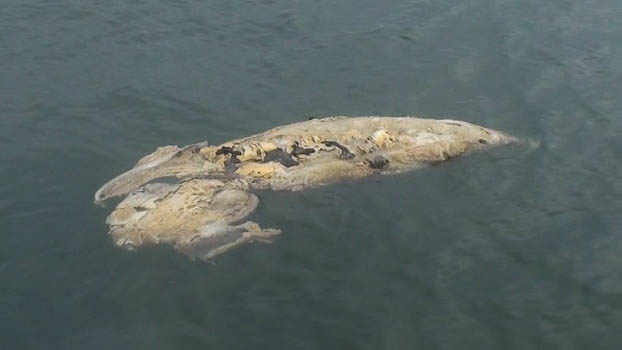Alex KainSeptember 27, 2009
In complete darkness, Captain Ahab thrust his head from the port window of his cabin and snuffed up the sea air like a "sagacious ship's dog". He smelled the whale. Minutes later, the salty, fishy smell became palpable to all. The ship changed course, heading toward the "peculiar odor". At daybreak, a "long sleek" confronted the ship directly ahead, "smooth as oil" and bouncing sunbeams to the ship. Ahab screamed, "Man the mastheads! Call all hands!" Daggoo woke the sleeping crewmen, who arrived to the deck with such alacrity that they were still dressed in their pajamas and holding work clothes in their hands. Crewmen hoisted Ahab to the viewing platform between the maintopsail and top-gallant-sail. In the distance he spotted her looking like "a hump in a snowhill". Ahab "raised a gull-like cry in the air, 'There she blows!--there she blows!. . .It is Moby Dick!'" * * * * *
In a turn of events worthy of Melville's pen, last afternoon the crew of the CCGS Louis S. St.-Laurent had a surprising encounter with a whale, or rather part of a whale carcass. Captain Andrew McNeill received word from Fisheries and Oceans Canada (DFO) that eight days before, another ship had spotted a dead whale near the Louis's present position. In order to assist DFO, the captain sent the helicopter to try to identify the whale species and determine the cause of death. The deployment of the helicopter exemplifies a principal function of the Canadian Coast Guard. Unlike its American analog, the Canadian Coast Guard is a non-militarized agency of the Canadian government that collaborates extensively with other organizations seeking maritime assistance. The experienced crewmen of the Canadian Coast Guard navigate challenging environments like the Beaufort Sea to faclitate shipping, scientific exploration, and, in this case, an aerial perspective to help the DFO find out why a whale carcass was floating in the middle of the Arctic Ocean. Whales migrate to the Beaufort Sea every year. For centuries, they have sustained Inuit communities and been fixtures in local mythologies. The myths show how native populations revere these beasts of the sea and the extent to which whales infuse local cultures. In one myth, an Inuit girl marries a whale straight from the sea. Last week, a few scientists aboard the Louis saw misty plumes in the distance, later hypothesized to come from a pod of Bowhead or Beluga Whales, two species found in the Beaufort Sea during September. When whales die, they either sink immediately or bloat and float. Floating whale bodies provide a non-stop buffet for birds and other marine life that feed off the available flesh. Animals nosh until the carcass loses the blubber and trapped gas that keep it buoyant and the whale’s skeleton drags the remains to the ocean floor. Once sunk, the bone and flesh remnants provide a seafood smorgasbord to bottom-dwelling creatures. Craig Smith, co-author of a February 2000 article published in Nature, performed research on whale gravesites using WHOI's research submersible ALVIN and found that a single whale fall, often containing more than 30 tons of organic material, can sustain over 30,000 animals of more than 200 species. When the helicopter found the body, it was a fraction of the animal's original size, thwarting attempts at species identification. The cause of the whale's death remains unknown. All text and photos property of Alex Kain unless otherwise indicated. Last updated: October 7, 2019 | |||||||||||||||
Copyright ©2007 Woods Hole Oceanographic Institution, All Rights Reserved, Privacy Policy. | |||||||||||||||



